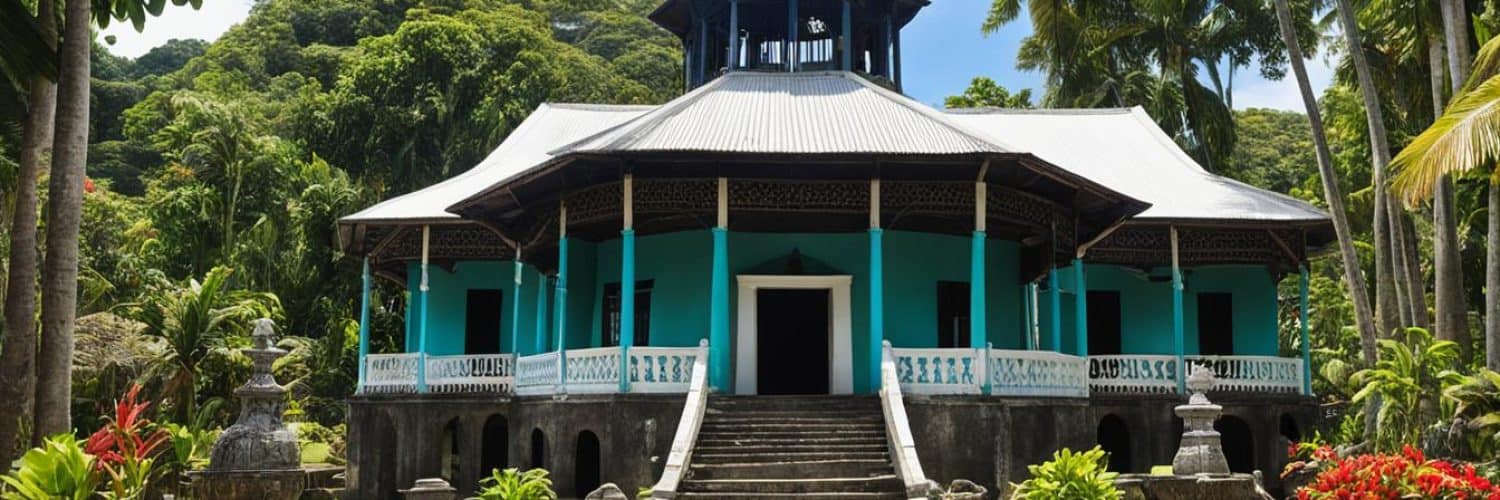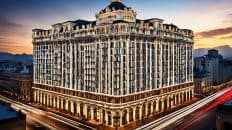If you’re looking to immerse yourself in the rich cultural heritage of Cebu, Philippines, a visit to the Boljoon Parish Museum is a must. Located in the town of Boljoon, this museum offers a fascinating glimpse into the region’s religious history and showcases a collection of historical exhibits and religious artifacts from the Spanish colonial era.
As you step into the museum, you’ll be transported back in time, surrounded by the preserved relics and treasures that tell the story of Boljoon’s past. From ecclesiastical and liturgical artifacts to handwritten documents by the priests, the museum provides an opportunity to explore the cultural significance of this charming town.
Experience the intricate craftsmanship of religious relics and marvel at the history they represent. The Boljoon Parish Museum is a celebration of the town’s vibrant heritage and a testament to its historical significance.
Key Takeaways:
- Visit Boljoon Parish Museum in Cebu, Philippines to explore the cultural heritage of the region.
- Marvel at the historical exhibits and religious artifacts that showcase the town’s rich history.
- Experience the preserved relics from the Spanish colonial era and gain insight into Boljoon’s past.
- Immerse yourself in the intricate craftsmanship and cultural significance of religious relics.
- The Boljoon Parish Museum is a captivating destination for history enthusiasts and those interested in the town’s heritage.
The Magnificent Boljoon Church
The Boljoon Parish Church, officially known as the Nuestra Señora del Patrocinio de Maria Parish Church, is a magnificent structure that dates back to the Spanish colonial era. It has been declared a National Historical Landmark and a National Cultural Treasure. The church’s architecture and design exemplify the Filipino Baroque style, and its thick stone walls and original terra cotta roof tiles are a testament to its historical significance.
| Features | Details |
|---|---|
| Architectural Style | Filipino Baroque |
| Date | Spanish colonial era |
| Declared Status | National Historical Landmark and National Cultural Treasure |
| Materials | Thick stone walls and original terra cotta roof tiles |
“The Boljoon Parish Church stands as a testament to the rich history of Boljoon and the Spanish colonial era. Its magnificent design and well-preserved features offer visitors a glimpse into the past.”
A Fortress Church and its Historical Significance
The Boljoon Parish Church played a vital role not only as a place of worship but also as a fortress during the Spanish colonial period. Positioned strategically by the coast, this magnificent church served as a coastal defense against relentless pirate attacks.
“The Boljoon Parish Church, with its fortress-like features, was our stronghold against marauders,” said Maria Victoria, a local historian.
The church’s impressive architecture, characterized by its thick stone walls and elevated windows, provided protection and refuge for the people of Boljoon during sieges. This robust structure acted as a shield, safeguarding the town from dreaded pirate invasions originating from Mindanao.
To understand the historical significance of the Boljoon Parish Church, one must look beyond its religious purposes. It stood firm as a coastal fortress, demonstrating the resilience and determination of the community to protect their home from external threats.
Leveraging Coastal Geography for Defense
The church’s strategic location by the coast was key to its effectiveness as a defensive structure. Positioned overlooking the sea, it provided an advantageous vantage point for early detection of approaching pirate ships.
The imposing stone walls, rising high above the water’s edge, served as a sturdy barrier against enemy forces. The church’s coastal defense system was designed to effectively repel attacks and discourage pirate raids, ensuring the safety of the town’s residents.
A Haven in Troubled Times
During times of pirate raids, the Boljoon Parish Church became a sanctuary and refuge for the people. Its fortified walls offered protection, providing shelter and solace for families seeking safety from the threats that loomed outside.
The church’s significance as a fortress extended beyond its physical attributes. It represented a symbol of resilience, unity, and unwavering faith in the face of adversity.
Preserving the Heritage
Today, the Boljoon Parish Church stands as a testament to its history as both a spiritual beacon and a fortress against pirate attacks. Its historical significance continues to captivate visitors, allowing them to immerse themselves in the rich cultural heritage of Boljoon.
The church’s remarkable blend of religious and defensive elements showcases the ingenuity and resourcefulness of the community in safeguarding their town. It serves as a lasting reminder of Boljoon’s enduring spirit and unwavering determination in the face of challenges.
| Key Points | Description |
|---|---|
| Strategic Location | The church’s positioning by the coast allowed for effective coastal defense against pirate attacks. |
| Robust Architecture | The thick stone walls and elevated windows served as protective features during sieges. |
| Symbol of Resilience | The church represents the community’s unwavering spirit and determination in safeguarding their town. |
| Cultural Heritage | The Boljoon Parish Church is a remarkable testament to Boljoon’s rich history and heritage. |
The Old Structures Within the Parish Complex
The Boljoon Parish Complex is not only home to the impressive Boljoon Parish Church but also houses several other old structures that hold significant historical value. These structures provide a glimpse into the past and showcase the architectural beauty of the Spanish colonial period in Boljoon.
The Rectory – A Residential Marvel
One of the largest and oldest residential buildings from the Spanish colonial period in Boljoon is the rectory. Built in 1847, it stands as a testament to the rich history of the town. The rectory features a traditional balay na bato architectural style, characterized by its stone walls and wooden upper floors. Its design harmoniously blends Spanish and Filipino influences, creating a unique and visually stunning structure. Today, the rectory serves as part of the Boljoon Parish Museum, housing a collection of cultural artifacts and exhibits that portray the town’s heritage.
Gates and Walls – Guardians of the Past
The Boljoon Parish Complex was not only aesthetically pleasing but also strategically designed with security in mind. The complex is fortified by gates and walls that once protected the church and its surrounding structures. These sturdy defense measures served as a barrier against potential threats from pirates and invaders during the Spanish colonial era. Today, while the threats may have dissipated, the gates and walls serve as a reminder of the town’s past and stand as enduring symbols of strength and resilience.
Take a moment to visualize the magnificence of these old structures by viewing the image below:
“The rectory and the gates and walls within the Boljoon Parish Complex are a testament to the rich history and architectural beauty of the Spanish colonial period in Boljoon.”
Exploring the Boljoon Parish Museum
The Boljoon Parish Museum, located within the rectory of the Boljoon Parish Complex, is a must-visit for history enthusiasts. This captivating museum showcases various cultural artifacts and historical relics dating back to the Spanish colonial period, offering visitors a unique opportunity to delve into the local history of Boljoon.
Upon entering the Boljoon Parish Museum, visitors are greeted with a fascinating collection of ecclesiastical and liturgical artifacts. These precious items provide a glimpse into the religious practices and traditions of the past. From intricately designed chalices to ornate religious vestments, the museum exhibits highlight the rich cultural heritage of Boljoon.
One of the highlights of the Boljoon Parish Museum is the display of parish records dating back to the 17th century. These meticulously preserved documents offer valuable insights into the history and development of the town. Visitors can trace the lineage of prominent families, discover historical events, and gain a deeper understanding of the community’s history.
“The Boljoon Parish Museum is a treasure trove of historical artifacts. It serves as a window to the past, allowing visitors to appreciate the cultural significance of Boljoon,” says local historian Dr. Maria Santos.
In addition to the ecclesiastical artifacts and parish records, the Boljoon Parish Museum also showcases handwritten documents by the priests who served in the area. These personal writings offer a glimpse into the daily lives and experiences of the clergy during the Spanish colonial period. Visitors can explore the letters, journals, and other writings, gaining a deeper appreciation for the history and cultural heritage of the region.
To enhance the visitor experience, the Boljoon Parish Museum offers guided tours led by knowledgeable docents. These tours provide detailed explanations and insightful anecdotes about the exhibited artifacts, bringing the history of Boljoon to life. Visitors can engage with the docents, ask questions, and deepen their understanding of the cultural significance of the displayed relics.
The Boljoon Parish Museum is not just a repository of historical artifacts; it is a testament to the rich heritage of Boljoon. It serves as a reminder of the town’s vibrant past and the resilience of its people. A visit to this remarkable museum is an opportunity to immerse oneself in the captivating history of Boljoon and appreciate the cultural treasures it holds.
| Cultural Artifacts | Historical Relics |
|---|---|
| 1. Ancient pottery | 1. 16th-century religious icons |
| 2. Traditional clothing | 2. Colonial-era manuscripts |
| 3. Indigenous musical instruments | 3. Preserved ceremonial objects |
| 4. Antique furniture | |
| 5. Spanish-era religious artifacts |
The Magnificent Boljoon Church Bell Tower
The Boljoon Church Bell Tower, also known as El Gran Baluarte, is a significant structure within the Boljoon Parish Complex. Originally built as a watchtower serving as a lookout and defense station, it now serves as the church’s belfry. The tower is unique in its simple design, with markings on its walls left by prisoners during the Spanish colonial period. Visitors can climb to the top and enjoy panoramic views of the surrounding area.
Key Features of Boljoon Church Bell Tower:
- Originally constructed as a watchtower for coastal defense
- Transformed into the church’s belfry
- Simple design with historical markings on its walls
- Offers visitors panoramic views of the area
“The Boljoon Church Bell Tower stands as a testament to the town’s rich history and architectural heritage.”
Experience the Boljoon Church Bell Tower:
When visiting Boljoon, don’t miss the opportunity to explore the magnificent Boljoon Church Bell Tower. As you ascend to the top, you’ll be transported back in time, taking in the breathtaking views of the surrounding area. Discover the tower’s historical significance and imagine the watchmen who once stood on its walls, keeping a vigilant eye out for any threats.
The Plaza Cemetery
The Boljoon Plaza Cemetery is a cherished site in the town, serving as its first Christian burial ground since the Spanish colonial period. With its rich history and significance, this cemetery holds a special place in the hearts of Boljoon’s residents.
Adorned with beautifully crafted gates made of cut coral stones, the Boljoon Plaza Cemetery features an elegant symmetrical design that exudes tranquility and reverence. As visitors enter this sacred space, they are greeted by a serene atmosphere that pays homage to the town’s ancestors and their lasting legacy.
Within the hallowed grounds of the cemetery, one can find the final resting place of many of Boljoon’s esteemed ancestors. These ancestral graves are a testament to the town’s deep-rooted heritage, and visiting the cemetery offers a unique opportunity for individuals to connect with their own family history while honoring the past generations who shaped Boljoon’s identity.
As visitors navigate through the rows of meticulously arranged burial plots, they gain a profound appreciation for the cultural significance and reverence placed on the Boljoon Plaza Cemetery. It is a place where families and friends come together to remember and pay tribute to their loved ones.
Stepping into the Boljoon Plaza Cemetery is like stepping into the pages of history, where the past seamlessly intertwines with the present. It stands as a powerful reminder of Boljoon’s rich heritage and the enduring bond between its people and their ancestral roots.
The Importance of Fr. Julian Bermejo
Fr. Julian Bermejo is a key figure in Boljoon’s history. He played a significant role in organizing the coastal defense system against pirate attacks during the Spanish occupation.
Fr. Bermejo’s coastal defense system involved the construction of watchtowers and fortifications along the coast, spanning a distance of 96 kilometers from Santander to Carcar.
His efforts were instrumental in safeguarding the town and its people during a turbulent period of constant threats from pirates. The coastal defense system implemented by Fr. Bermejo ensured the safety of Boljoon and the surrounding areas from intruders.
| Coastal Defense System Components | Location |
|---|---|
| Watchtowers | Strategically placed along the coast, providing a vantage point to spot approaching pirate vessels. |
| Fortifications | Strong defensive structures equipped with cannons and other defensive mechanisms. |
Fr. Julian Bermejo’s dedication and strategic planning helped bolster Boljoon’s defenses and create a sense of security among its residents. His contributions to the coastal defense system laid the foundation for the town’s resilience and survival in the face of external threats.
“Thanks to Fr. Bermejo’s initiative, Boljoon was able to withstand numerous pirate attacks. His leadership and foresight were crucial in protecting the town and its people.”
Fr. Julian Bermejo’s legacy continues to be remembered and celebrated in Boljoon. His efforts to establish a formidable coastal defense system have left an indelible mark on the town’s history and serve as a testament to the resilience of its people.
Image: Fr. Julian Bermejo, the key figure in organizing Boljoon’s coastal defense system during the Spanish occupation.
Escuela Catolica and Plaza Bermejo
Located in Boljoon, the Escuela Catolica is a historic building that played a vital role in the town’s educational history. It served as a dormitory for children receiving religious instructions and primary education. Reflecting American construction influences, this iconic structure stands as a tribute to the town’s commitment to education.
Just across the road from the church, you’ll find Plaza Bermejo, a coastal park dedicated to Fr. Julian Bermejo. This serene location offers a perfect haven for leisurely walks and relaxation, with stunning views of the ocean. Take a moment to breathe in the fresh sea air and appreciate the scenic beauty of Plaza Bermejo.
Boljoon’s Quaint Church Plaza
The Boljoon Church Plaza is a charming space located between the church and the road, offering a serene ambiance that adds to the spiritual atmosphere of the area. Over the years, the plaza has become a central gathering place for religious activities and festivities in Boljoon. It has been an integral part of the town’s cultural and religious traditions, hosting processions, religious events, and celebrations.
Surrounded by the picturesque views of the Boljoon Parish Church, Ili Rock, and the enchanting town cove, the church plaza provides a perfect setting for various religious activities. The peaceful and tranquil environment of the plaza allows worshippers and participants to immerse themselves fully in the spiritual significance of the events.
Locals and visitors alike find solace in the serene beauty of the Boljoon Church Plaza, making it a popular destination for prayer, reflection, and contemplation. Its historical and cultural significance, combined with the natural beauty of the surroundings, creates a harmonious atmosphere that resonates with people from all walks of life.
The Boljoon Church Plaza serves as a reminder of the deep-rooted religious traditions and the strong community bonds in Boljoon. The sight of people coming together in prayer and celebration, accompanied by the sound of hymns and the fragrance of incense, creates a truly uplifting experience.
From vibrant processions to solemn religious ceremonies, the Boljoon Church Plaza continues to be a central hub for religious activities, fostering a sense of unity and devotion among the people of Boljoon.
Experience the spiritual and cultural splendor of Boljoon’s Quaint Church Plaza, where history and faith converge in a picturesque setting.
“The Boljoon Church Plaza is not just a physical space; it is a symbolic representation of the deep religious roots and communal spirit of the people of Boljoon.” – Local resident
| Religious Activities | Processions |
|---|---|
| Prayer services | Religious icons |
| Feast day celebrations | Devotional rituals |
| Mass gatherings | Pilgrimages |
Immerse Yourself in Boljoon’s Cultural Heritage
Boljoon, a town nestled in Cebu, Philippines, is a treasure trove of cultural heritage and historical significance. With its well-preserved structures and captivating landmarks, Boljoon offers visitors a unique opportunity to step back in time and immerse themselves in the rich history and heritage of the area.
At the heart of Boljoon’s cultural heritage lies the magnificent Boljoon Parish Church. This architectural marvel, dating back to the Spanish colonial era, stands as a testament to the town’s religious and historical significance. Its intricate design and fascinating details showcase the Filipino Baroque style, captivating visitors with its beauty and grandeur.
“Exploring Boljoon’s well-preserved structures is like taking a journey into the Spanish colonial period, offering a glimpse into the town’s vibrant past.”
Within the Boljoon Parish Complex, visitors can discover a myriad of historic buildings that add to the town’s allure. The rectory, a grand residential building built in 1847, showcases the traditional balay na bato architectural style. It serves as a tangible link to Boljoon’s past, providing a glimpse into the lives of the people who lived during the colonial era. The gates and walls, once guardians of the church and its surroundings, stand as proud reminders of Boljoon’s fortification against external threats.
The Boljoon Parish Museum, located within the historic rectory, is a must-visit for those seeking a deeper understanding of Boljoon’s cultural heritage. The museum houses a collection of cultural artifacts and historical relics, including ecclesiastical and liturgical treasures, handwritten documents by the priests, and parish records dating back centuries. These precious artifacts offer valuable insights into the lives of the past inhabitants and the vital role that religion played in shaping Boljoon’s history.
To further enrich their exploration, visitors can ascend the Boljoon Church Bell Tower, known as El Gran Baluarte, and soak in the panoramic views of the surrounding area. The tower’s simple yet sturdy design transports visitors to a time when watchtowers stood as silent sentinels, protecting the town from marauders.
Boljoon’s Cultural Heritage
| Attraction | Description |
|---|---|
| Boljoon Parish Church | A magnificent Spanish colonial church that exemplifies the Filipino Baroque style. |
| Boljoon Parish Museum | A repository of cultural artifacts and historical relics from Boljoon’s past. |
| Boljoon Church Bell Tower | A historic watchtower turned belfry with stunning views of the surrounding area. |
| Boljoon Parish Complex | A complex of well-preserved structures, including the rectory, gates, and walls. |
Exploring Boljoon’s cultural heritage is an experience unlike any other. As visitors wander through the town’s streets, they become intertwined with stories of the past, gaining a deeper appreciation for Boljoon’s historical significance. The preservation of Boljoon’s cultural heritage ensures that future generations can continue to learn and be inspired by this remarkable town and its captivating history.
Conclusion
Discover the captivating heritage of Boljoon Parish Museum in Cebu, Philippines. This remarkable museum is a treasure trove for history enthusiasts, offering a fascinating journey into the cultural and religious past of the area. With its impressive collection of historical exhibits and religious artifacts, visitors can delve into the rich tapestry of Boljoon’s history.
One of the highlights of Boljoon Parish Museum is its display of religious artifacts, showcasing the devotion and faith of generations past. From intricately crafted religious statues to precious liturgical items, these artifacts provide a glimpse into the deep spiritual heritage of the region. They illuminate the religious practices and traditions that have shaped Boljoon’s cultural identity.
The museum is complemented by the majestic Boljoon Parish Church and the surrounding structures within the Parish Complex. These architectural gems are magnificent examples of Spanish colonial architecture, standing as a testament to the region’s historical significance. Exploring Boljoon is an opportunity to immerse oneself in the grandeur and rich heritage of the town.
Embark on a captivating journey through time at Boljoon Parish Museum and experience the allure of Boljoon’s cultural and religious history. Marvel at the historical exhibits, admire the religious artifacts, and be inspired by the magnificent structures within the Parish Complex. Boljoon offers a unique blend of history, art, and spirituality, inviting visitors to appreciate the incredible richness of the region’s heritage.
FAQ
What can I expect to see at Boljoon Parish Museum?
At Boljoon Parish Museum, you can expect to see a variety of cultural artifacts and historical relics from the Spanish colonial period. The museum showcases ecclesiastical and liturgical artifacts, parish records dating back to the 17th century, and handwritten documents by the priests.
What is the historical significance of Boljoon Parish Church?
Boljoon Parish Church, also known as Nuestra Señora del Patrocinio de Maria Parish Church, holds great historical significance. It dates back to the Spanish colonial era and has been declared a National Historical Landmark and a National Cultural Treasure. The church’s architecture and design exemplify the Filipino Baroque style.
Did Boljoon Parish Church serve any other purposes besides worship?
Yes, Boljoon Parish Church also served as a fortress during the Spanish colonial period. Its strategic location by the coast allowed it to function as a defense against pirate attacks. The church’s thick stone walls and high windows provided protection and refuge for the people of Boljoon during sieges.
What are the attractions within the Boljoon Parish Complex?
The Boljoon Parish Complex houses several old structures of historical significance. These include the rectory, built in 1847 and featuring a traditional balay na bato architectural style, as well as the gates and walls that once protected the church and other structures in the area.
Can I climb the Boljoon Church Bell Tower?
Yes, visitors can climb the Boljoon Church Bell Tower, also known as El Gran Baluarte. Originally built as a watchtower, it now serves as the church’s belfry. The tower offers panoramic views of the surrounding area and provides a unique perspective on Boljoon’s history.
What is the significance of Boljoon Plaza Cemetery?
Boljoon Plaza Cemetery is the town’s first Christian burial ground, dating back to the Spanish colonial period. Many of Boljoon’s ancestors are buried here, making it an important site for ancestral heritage and remembrance. The cemetery features cut coral stone gates and a symmetrical design.
Source Links
- https://www.tripadvisor.com/Attraction_Review-g1514542-d1553858-Reviews-Patrocinio_de_Maria_Church-Boljoon_Cebu_Island_Visayas.html
- https://www.tripadvisor.com/Attraction_Review-g1514542-d2465590-Reviews-Boljoon_Parish_Museum-Boljoon_Cebu_Island_Visayas.html
- https://www.mycebu.ph/article/boljoon-cebu-attractions/











Add comment